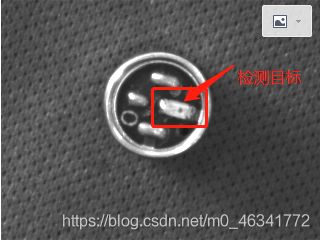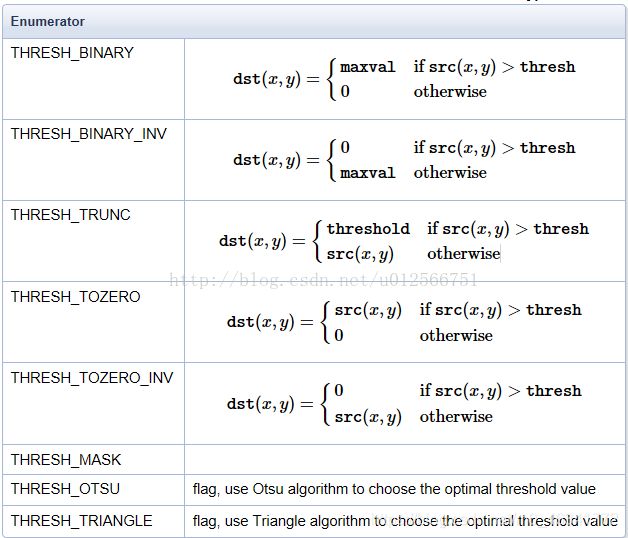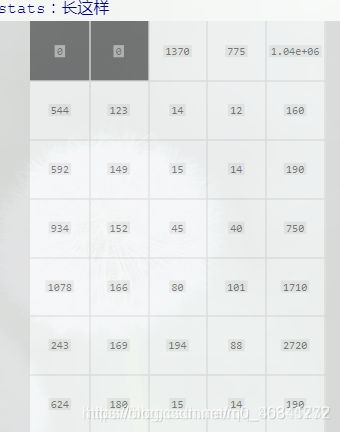树莓派系列四:openCV之计算目标的偏移角度
前言
上一篇为文中和大家分享如何检测图像中的圆,本篇继续和大家分享项目中的其他内容,项目的目标是坚持检测物体中的一个晶体,并计算它的偏移角度。

思路
知识点
- 二值化
图像的二值化就是将图像上的像素点的灰度值设置为0或255,这样将使整个图像呈现出明显的黑白效果。在数字图像处理中,二值图像占有非常重要的地位,图像的二值化使图像中数据量大为减少,从而能凸显出目标的轮廓。OpenCV中提供了函数cv::threshold();
函数原型:
double cv::threshold(InputArray src,
OutputArray dst,
double thresh,
double maxval,
int type)
参数说明
src:源图像,可以为8位的灰度图,也可以为32位的彩色图像。(两者由区别)
dst:输出图像
thresh:阈值
maxval:dst图像中最大值
type:阈值类型,可以具体类型如下:

- 连通域分析
函数原型:
int cv::connectedComponents (
cv::InputArrayn image, // //8位单通道二值图像 (binary)
cv::OutputArray labels, // output label map //和原图一样大的标记图
int connectivity = 8, // 4- or 8-connected components
int ltype = CV_32S // Output label type (CV_32S or CV_16U)
);
int cv::connectedComponentsWithStats (
cv::InputArrayn image, // input 8-bit single-channel (binary)
cv::OutputArray labels, // output label map
cv::OutputArray stats, // Nx5 matrix (CV_32S) of statistics:
// [x0, y0, width0, height0, area0;//nccomps×5的矩阵 表示每个连通区域的外接矩形和面积(pixel)
// ... ; x(N-1), y(N-1), width(N-1), height(N-1), area(N-1)]
cv::OutputArray centroids, //nccomps×2的矩阵 表示每个连通区域的质心(pixel)Nx2 CV_64F matrix of centroids: [ cx0, cy0; ... ; cx(N-1), cy(N-1)]
int connectivity = 8, // 4- or 8-connected components
int ltype = CV_32S // Output label type (CV_32S or CV_16U)
);
其中connectedComponents()仅仅创建了一个标记图(图中不同连通域使用不同的标记,和原图宽高一致),connectedComponentsWithStats()可以完成上面任务,除此之外,还可以返回每个连通区域的重要信息–bounding box, area, andcentroid
参数说明:
该函数有返回值,返回一个int整型 nccomps,函数返回值为连通区域的总数N,范围为[0,N-1],其中0代表背景。
image:输入8位单通道二值图像;
label:输出,和原图image一样大的标记图,label对应于表示是当前像素是第几个轮廓,背景置0;
centroids:对应的是轮廓的中心点。nccomps×2的矩阵 表示每个连通区域的质心
stats:输出,nccomps×5的矩阵 ,表示每个连通区域的外接矩形和面积(pixel),例如下列:

最终效果:

部分代码
Mat cimg;
medianBlur(src,src,5);
cvtColor(src,cimg,COLOR_BGR2GRAY);
GaussianBlur(cimg,cimg,Size(9,9),2,2);
Canny(cimg,cimg,10,250,5);
//imwrite("canny1.bmp",cimg);
vector<Vec3f> circles;
size_t i;
for(i = 0; i < 5; i++)
{
circles.clear();
HoughCircles(cimg,circles,HOUGH_GRADIENT,1,30,100,100-i*10,10,120);
printf("circles.size()=%d\n",circles.size());
if(circles.size() > 0)
{
break;
}
}
int maxRadius = 0;
int m = 0;
for( i = 0; i < circles.size(); i++)
{
int radius = cvRound(circles[i][2]);
if(maxRadius < radius)
{
maxRadius = radius;
m = i;
}
}
Point center(cvRound(circles[m][0]),cvRound(circles[m][1]));
printf("maxRadius= %d\n",maxRadius);
maxRadius = maxRadius-10;
Mat srcMat=src(Rect(center.x-maxRadius,center.y-maxRadius,maxRadius*2,maxRadius*2));
//imwrite("22.bmp",srcMat);
Mat lableMat;
Mat statsMat;
Mat centerMat;
Mat srcMat1;// = imread("D:\\opencv_picture_test\\轮廓\\die_on_chip.png", 1); //读取灰度
Mat dstMat;
cvtColor(srcMat, srcMat1, COLOR_BGR2GRAY);
//调用阈值函数
threshold(srcMat1, dstMat, 150, 255,THRESH_BINARY);
//imshow("bin", dstMat);
//腐蚀操作
//Mat element = getStructuringElement(MORPH_ELLIPSE, Size(9,9));
//morphologyEx(dstMat,dstMat, MORPH_ERODE, element);
int nComp = cv::connectedComponentsWithStats(dstMat,
lableMat,
statsMat,
centerMat,
8,
CV_32S);
int maxSize = 0;
m = 1;
for (int i = 1; i < nComp; i++)
{
if(maxSize < statsMat.at<int>(i, 4) && statsMat.at<int>(i, 2) < 60 && statsMat.at<int>(i, 3) < 60)
{
maxSize = statsMat.at<int>(i, 4);
m = i;
}
}
Rect bndbox;
bndbox.x = statsMat.at<int>(m, 0);
bndbox.y = statsMat.at<int>(m, 1);
bndbox.width = statsMat.at<int>(m, 2);
bndbox.height = statsMat.at<int>(m, 3);
//if (fabs(bndbox.width * 1.0 / bndbox.height - 1) < 0.2 && statsMat.at(i, 4)>=20)
rectangle(srcMat, bndbox, CV_RGB(0, 255, 255), 1, 8, 0);
line(srcMat, Point(srcMat.cols/2, srcMat.rows/2), Point(bndbox.x+bndbox.width/2, bndbox.y+bndbox.height/2), Scalar(0, 0, 255), 1);
THE END
![]()
扫描上方二维码关注“嵌入式案例Show”公众号,看更多嵌入式案例

